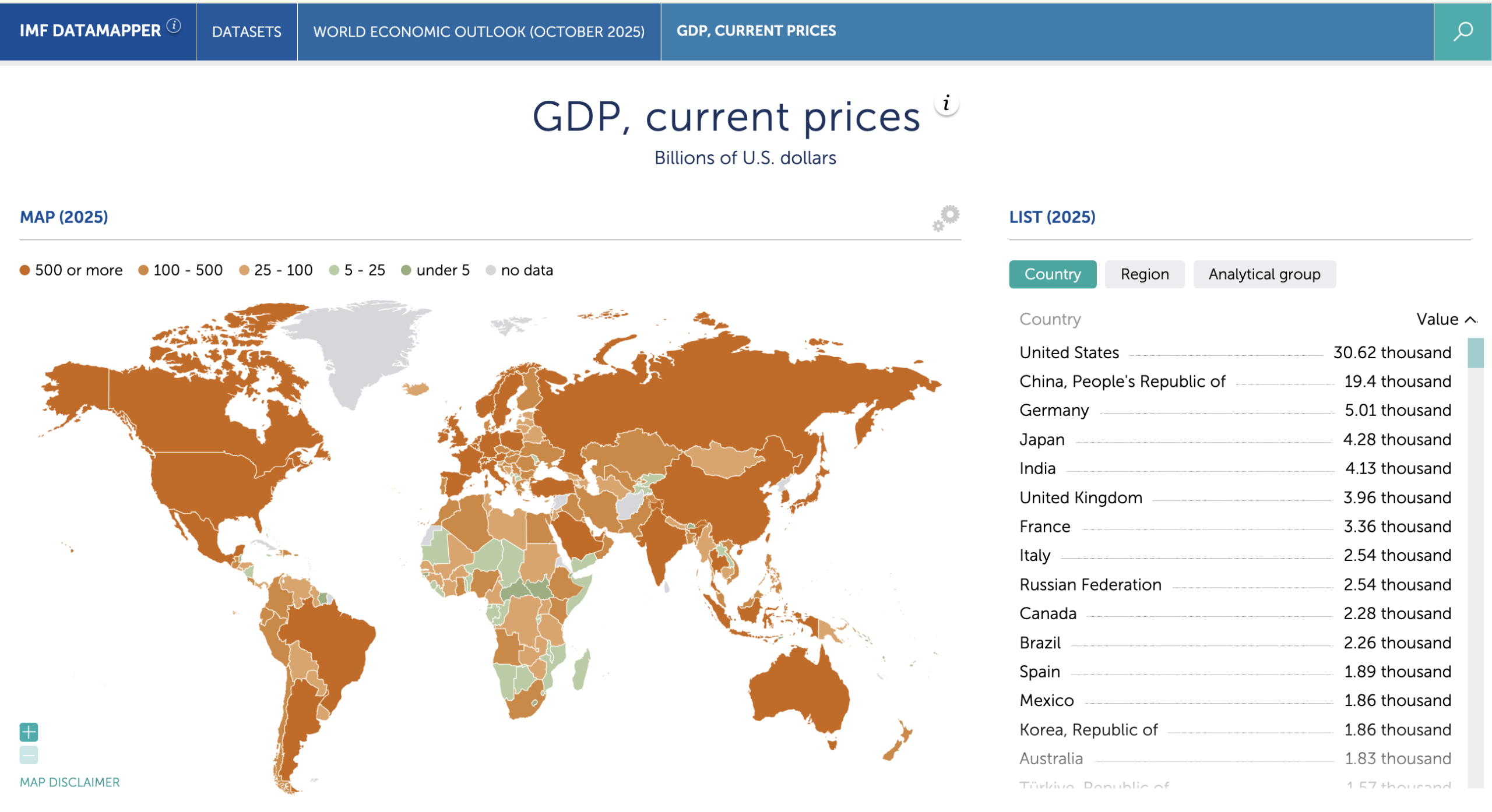
Top 15 Economies in the World in 2025 – New York Institute of Finance
Where Wall Street Goes to School™
The size of a country’s economy is typically measured using Gross Domestic Product (GDP). GDP reflects the total monetary value of all goods and services produced within a nation and is the most widely accepted way to compare the largest economies in the world.
Using the latest IMF DataMapper (October 2025), here are the updated rankings of the world’s biggest economies based on nominal GDP at current prices.
Top 15 Largest Economies in the World (2025)
- United States — $30.62 trillion
The United States remains the world’s largest economy by a significant margin. Its strength comes from innovation, advanced infrastructure, a dominant services sector, world-leading financial markets, and strong consumer spending. The U.S. continues to represent a major share of global GDP.
- China — $19.4 trillion
China holds the second spot among the largest economies in the world, powered by its massive manufacturing base, rapid technological development, and rising domestic consumption. While China’s growth has moderated in recent years, the country remains an essential driver of global trade and production.
- Germany — $5.01 trillion
Germany leads Europe as the continent’s biggest economy. Its GDP is driven by high-value manufacturing, automotive exports, engineering, and industrial technology. Despite global economic uncertainty, Germany continues to be a core pillar of the European and global economy.
- Japan — $4.28 trillion
Japan maintains the fourth position, supported by advanced manufacturing, technology leadership, and a highly skilled workforce. Although Japan faces demographic challenges and slow growth, its economy remains one of the highest GDP countries globally.
- India — $4.13 trillion
India continues its rapid ascent, becoming one of the world’s most dynamic and fastest-growing major economies. With strong growth in digital services, technology, and financial services, India has firmly secured its place in the top five largest economies.
- United Kingdom — $3.96 trillion
The UK retains its position in the global top 10, driven largely by its financial services industry, technology, pharmaceuticals, and a strong services sector. Despite economic adjustments following Brexit, the UK remains one of the world’s major economic centers.
- France — $3.36 trillion
France hosts one of the most diversified economies in Europe. Key contributors include tourism, luxury goods, aerospace, manufacturing, and agriculture. France remains a major trade and financial hub within the EU.
- Italy — $2.54 trillion
Italy ranks eighth, with strengths in fashion, automotive production, machinery, food exports, and design-oriented manufacturing. Although the country faces structural and demographic challenges, its economy continues to be influential in Europe.
- Russia — $2.54 trillion
Russia’s economy continues to be driven primarily by energy exports—especially oil and natural gas. Despite geopolitical challenges and sanctions, Russia’s sizable natural resource sector keeps it among the world’s largest economies.
- Canada — $2.28 trillion
Canada remains a top global economy due to its natural resources, stable banking system, strong exports, and growing technology sector. Its close economic integration with the United States also supports stable growth.
- Brazil — $2.26 trillion
Brazil is the largest economy in Latin America, driven by agriculture, mining, energy, and manufacturing. Despite political and economic fluctuations, Brazil remains an essential player among emerging markets.
- Spain — $1.89 trillion
Spain’s economy benefits from strong tourism, services, exports, and growing digital sectors. Following previous downturns, Spain continues to rebuild its position as a major European economy.
- Mexico — $1.86 trillion
Mexico remains a key manufacturing and export hub, deeply integrated into North American trade networks. Its automotive and industrial production sectors drive much of its GDP growth.
- South Korea — $1.86 trillion
South Korea is one of the most technologically advanced countries in the world, home to major global brands in electronics, automotive, and heavy industry. This keeps it firmly within the top global economies.
- Australia — $1.83 trillion
Australia’s economy benefits from natural resources, stable institutions, financial services, and strong trade relationships—especially within Asia. Its long-term economic stability keeps it among the world’s largest.
Summary
The rankings of the largest economies in the world shift over time due to changes in growth rates, exchange rates, global trade, demographics, and geopolitics. The 2025 IMF rankings highlight:
- Continued dominance from the U.S. and China
- Steady economic strength in Europe
- Rapid growth from India
- Resilience from major emerging markets like Brazil and Mexico
About The New York Institute of Finance
The Original Finance Credential that gets you hired, promoted, or certified. For more than 103 years, the New York Institute of Finance (NYIF) has been the training ground of Wall Street, developing the practical, job-ready skills demanded by global financial institutions. Founded by the New York Stock Exchange in 1922, NYIF delivers practitioner-led education across investment banking, financial modeling, risk management, accounting, market structure, and more. Learners can study online, self-paced, live virtual, or at our New York campus, guided by active industry professionals who teach real-world finance—not theory. Today, NYIF’s credentials empower 1.5M+ alumni each year to advance their careers in over 120 countries, making it one of the most trusted and recognized names in global financial education.
Explore 200+ NYIF finance programs here to learn directly from Wall Street practitioners across the stock market, financial modeling, accounting, capital markets, and more.

